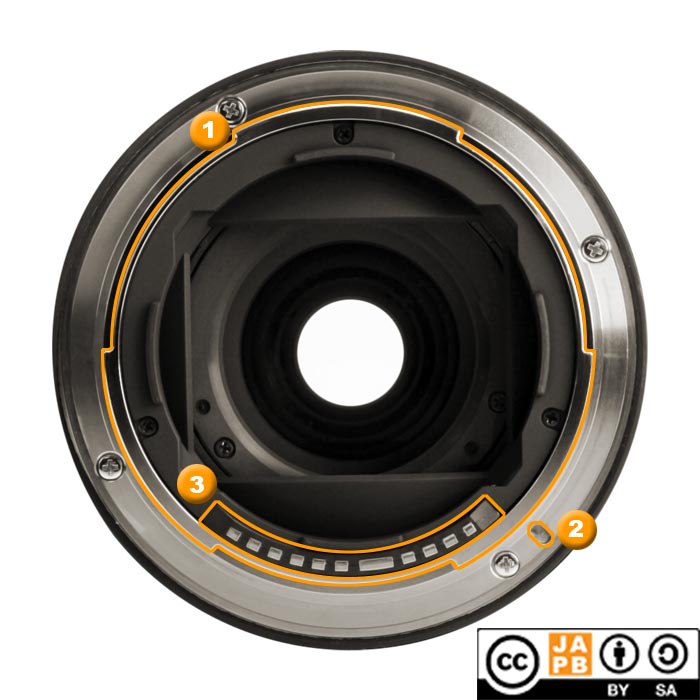Pekka Buttler, (Updated 5/2025)
The Fujifilm G is a digital medium format mount that is more interesting as a mount to be adapted to (than as a mount to be adapted).
Fujifilm G mount specifications and identification
Mount type: Bayonet mount (lens release on camera)
Flange focal distance: 26,70 mm
Frame size: 43,8mm x 32,9 mm (digital medium format)
Mount communication:
• focusing, aperture command & control (body-to-lens) focusing distance, lens information (lens-to-body), using 11 electronic contacts

Key characteristics of Fujifilm G mount:
[1] Three-pronged male bayonet. All edges straight
[2] Locking notch at 04:30
[3] 11 electronic contacts (spring-loaded at the camera-end) between 05:00 and 7:00.
(There are fully manual Fujifilm G lenses that do not offer electronic contacts)
Basic Information on the Fujifilm G mount:
Fujifilm is no new entrant into the photographic industry. On the contrary, Fujifilm has an almost century long history in the business. Moreover for more than half a century Fujifilm been a strong player in both cameras (from compacts to medium and large format gear), lenses and (surprise!) film. However , as discussed in more detail in the JAPB article on the Fujica X mount, Fujifilm decided to withdraw from the business of making interchangeable lens cameras for 35 mm film (the consumer segment) in 1985 and thereafter focused on film, compacts and medium format (and larger) cameras.
After the advent of digital photography Fujifilm largely kept its cool. Fujifilm compacts were replaced by digital point-and-shoot cameras, while the pro-segment remained solidly film-based. Notwithstanding a dalliance with repurposing Nikon film and digital bodies and selling these as Fuji FinePix Sx Pro cameras, Fuji kept resolutely away from any pr/ofujifilenthusiast interchangeable lens digital cameras.
That all changed in January 2012 with the introduction of the Fujifilm X-Pro1 mirrorless, rangefinder-style camera and the Fujifilm X mount. While these cameras were largely well-received, Fuji was criticised in some circles for only offering APS-C size sensor cameras.
Instead of extending the lineup upwards by introducing a full frame camera, Fujifilm went one step further and introduced the Fujifilm GFX Digital medium format system in 2016 with its new Fujifilm G lens mount. Today the Fujifilm G system comprises of a number of cameras and a lineup of Fujifilm G lenses manufactured both by Fuji and third party manufacturers.
Adapting to Fujifilm G bodies
‘Blessed’ with a combination of a digital medium format sensor, a relatively short flange focal distance (long for mirrorless but short enough to adapt most lenses) and very expensive native lenses, adapting legacy lenses to the Fujifilm G systems has become very popular.
Obviously the Fujifilm G system has some limitations. Firstly, as the sensor size exceeds that of ‘full-frame’ lenses will vignette more and not all lenses have image circles that will cover the Fujifilm G system’s sensor. Hence, there is significant lens-to-lens variation between whether the lenses will be adaptable without issue. If you’re planning to procure a legacy full-frame lens for adapting it to a Fujifilm G system, it generally pays to do some research or ask on one of those many forums/groups that discuss adapting legacy lenses to Fujifilm G.
Secondly, with a flange focal distance of 26,7 mm (long for a mirrorless mount), not all lenses that can be adapted to Sony FE or other full frame mirrorless mounts can be adapted to Fujifilm G (without losing infinity focus). Simultaneously, the list of such mounts cannot be considered to be long, nor does it continue anything especially field-relevant.
On the other hand, the Fujifilm G system is today among the best systems if your intention is to adapt legacy medium format lenses – whether Fuji or other medium format lenses – as long as a suitable adapter can be found or manufactured.
Adapting Fujifilm G lenses
Fujifilm G lenses are designed to cover digital medium format and to be used at the Fujifilm G mount’s flange focal distance. Moreover, most of Fuji’s native Fujifilm GFX lenses are heavily reliant on communicating with the camera. As always, lenses that rely on communication with a camera body for some or all of their functionality would need a smart adapter to function and – as of this writing no such adapters seem to exist.
Manual Fujifilm G lenses that do not have electronic contacts (and hence cannot depend on communicating with a body) could theoretically be adapted to any system that has a sufficiently shorter flange focal distance and would physically accommodate Fujifilm G lenses (because the diameter of the Fujifilm G mount places some demands). Hence, manual Fujifilm G mount lenses should theoretically be adaptable to Hasselblad as well as all other systems that have shorter1 flange focal distances (e.g. Sony FE, Fujifilm X, Nikon Z) assuming the front of the camera can accommodate the size of Fujifilm G lenses. However, to the best of my knowledge no such adapters exist.
Footnotes:
1 This is pure guesswork on my part, but I find it possible that one could not manufacture an adapter from Fujifilm G to L-system or Canon RF in the 6,7 mm available when considering the larger diameter of the Fujifilm G mount. Anyone who knows better, please inform me.